How I Went From Dancer to Tour Guide in One Creation by Ori Lenkinski
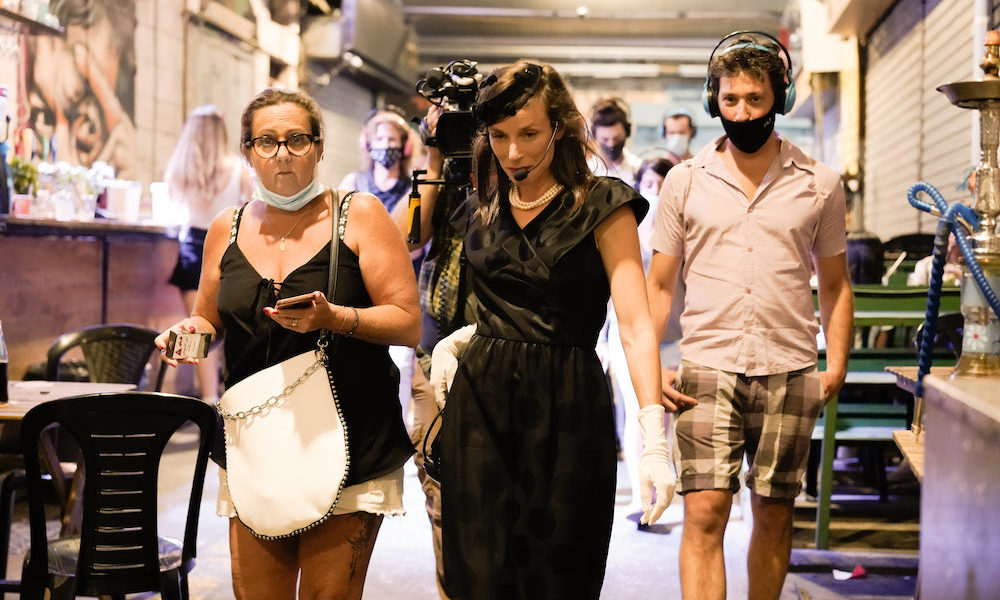
*originally published in Hebrew in Israel Dance Diaries 39- מחול עכשיו
Almost six months to the day after my last performance I premiered Meet Me in the Market.
On March 6, when The Suit took part of the Women Festival at the Holon Theater, I finished two performances, checked the box in my mind that I had completed the engagement and looked onwards to a month and a season full of shows and tours. Little did I, or anyone else, know that it would be my last meeting with an audience for a long while. So when I walked down the stairs of the Alliance House on September 9, onto the site-specific “stage” that would be the stomping ground for Meet Me in the Market, a performative tour of Jerusalem’s Mahane Yehuda Market inspired by Jackie Kennedy, the impact was amplified exponentially. It would have been an intense production to put on in any situation. The market, nighttime, the throngs of people just days before the new year, the roaring music, hookah smoke, salespeople’s calls, all this as the backdrop to an hour-long walking tour in which I was in character, in heels and it was a lot. But the shock of seeing so many faces after seeing so few, that was what made the experience truly unique.
To explain how I arrived at Meet Me in the Market, I have to go back about four years, to the creative process for a piece I made for Tmuna Theater’s Intimadance Festival in 2017. I had pitched an idea, on paper, to the festival directors and was invited in for a presentation. The idea was quite simple; I wanted to restage Rachel Kafri’s 1977 creation Portrait of a Demagog, which was one of five solos Ruth Eshel performed in a solo evening of her own direction. I became aware of this piece thanks to an article I wrote for the Jerusalem Post about Eshel’s two-tome dance retrospective, Dance Spreads Its Wings. Following our interview over hot chocolates in the Max Brenner beneath her apartment, we went upstairs, where Eshel showed me pictures from her decades of performance. Almost as an afterthought, she gifted me a DVD of that fateful solo evening. Back at home, while reviewing the materials, I decided to take a look. That same week, Anat Katz and Erez Maayan put out to call for proposals for Intimadance, for which they were the artistic directors in 2017 and 2018. The theme that year was Appropriate Response. In the description of this topic, they wrote of old and new. Watching Kafri’s creation, I was struck by a thought. Could anyone discern this work from the new creations being presented today? Were I to perform this work without any additional information, would the audience be able to tell that it was forty years old? And so, with those questions in mind, I submitted my proposal to restage the piece. I had little doubt that it would be turned down.
Upon receiving my invitation to present five minutes of material, I was flustered. I had no idea where to begin. I felt that, beyond learning the choreography, I had to add my two cents. Otherwise, it seemed to me, I would not have created a response, only positioned the original.
In the solo, Kafri chose to project images of world leaders on the backdrop of the stage. Hitler, Mussolini, Churchill… these faces popped up behind Eshel and a life-size doll bopping along for the ride, strapped to Eshel’s back.
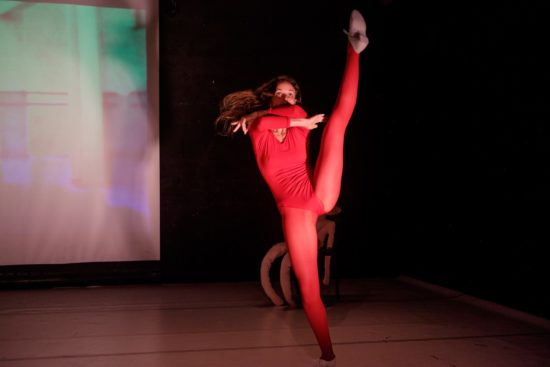
Photo by Dan Ben Ari
I decided to shift the perspective to female leaders. I looked at a number of female presidents and prime ministers throughout the decades. I came upon many first ladies as well. I began to explore the difference in tone and physicality between female leaders and the wives of male leaders. What freedoms did first ladies have that female presidents did not and vice versa? Naturally, my research about first ladies led me to Jackie Kennedy and Michelle Obama. I put together a short segment in which I recited a speech by Obama while embodying Kennedy’s telltale breathy voice and demure gestures. The contrast between the two women was intriguing to me.
In the presentation itself, the artistic directors were far more interested in the original choreography. I understood, from their response, that I was working on two solos at the same time; the restaging of Portrait of a Demagog and whatever this first lady investigation was. So I put Jackie and Michelle aside and focused on Kafri and Eshel. My eventual creation, Portrait #2, ended up being a duet/discussion with Eshel in which I performed the entire solo followed by a delightful improvisation by Eshel.
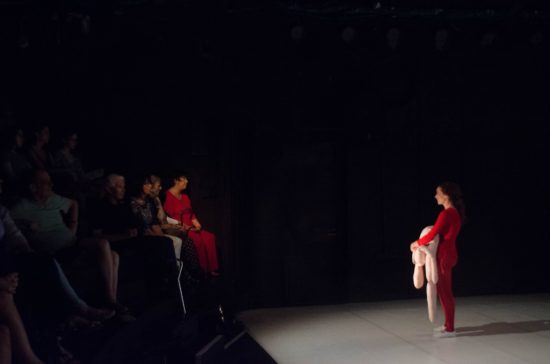
Photo by David Kaplan
Two years later, Intimadance was placed in the hands of Renana Raz and Ofer Amram. The theme was icons. When I saw the call for proposals, I immediately thought of Jackie Kennedy. I had a strong feeling that, if there was to be a festival about icons, Jackie had to be there and I was probably the only person in the Israeli contemporary dance community that would want to bring her.
As with the previous time, I sent a written proposal. It spoke of Jackie’s pink suit, of her elegance and her marriage, her tragedy and remarriage. For the presentation, I went back to a video I had come across in that first dabble with her in which she gave a tour of the White House. On Valentine’s Day, 1962, Kennedy hosted a CBS film crew at the White House. She was in the midst of a massive redesign of the interiors of the White House and invited viewers into the presidential chambers for the first time to see what she had accomplished. Prior to the Kennedy’s election, presidents could bring in any furniture they liked to the White House. They could dispose of anything they didn’t fancy and could take whatever they liked upon leaving. Jackie didn’t agree with this. She spent months raising funds and tracking down historic pieces that she and a team of experts identified in old photographs and writings. They found desks, tables, candlesticks, paintings and more throughout the United States and slowly, one piece at a time, refurbished them and returned them to their rightful places. In the hour-long special on CBS, which won an Emmy and was viewed by millions around the world, Jackie walked from room to room displaying an uncanny knowledge of design and architecture. She knew the origin and style of every single thing in the White House. As a result of her work, the laws surrounding the White House’s interiors were changed and today, presidents may put pieces in storage but may not take or discard anything in the building.
I watched the video countless times. I was fascinated by her voice, her gait and her presence. She was incredibly modest, bashful even but insistent on the information she wanted to convey. She was interrupted countless times by the interviewer but remained composed, smiling while returning to the thought she had begun.
I decided to use the tour as the springboard for my presentation. I wrote a short tour of Tmuna Theater’s Parking Lot from memory, highlighting certain points that stood out to me. Whereas Jackie was giving a tour of one of the most impressive homes in the country, I would be showcasing a beloved yet dilapidated building. Tmuna is a far cry from the luxury and pomp of the White House. Something in that contrast spoke to the pull I felt towards Jackie. I wondered what it would be like to keep up the face that she had in her tour in much worse circumstances. I thought that pushing this character to the extreme, placing her so far out of her comfort zone yet keeping her poised and positive, would be explosive. I hoped that it would point to the impossibilities of being a woman today. I planned to begin with the tour and move on to the rest of Jackie’s life and being after but I never really got past it.
From the presentation, it was clear that the tour of Tmuna worked. It was, surprisingly to me, funny. After being accepted to the festival, I began to work on the piece. I left the tour aside and focused on movement, being a dancer first and foremost. I felt that I could not simply give a comedic, presidential tour of the theater, that there had to be choreography and by choreography I thought of dance steps. So, I began putting together bits of music sampled from an album I discovered called Music from the Kennedy White House. I choreographed some movement phrases, mostly repetitive interludes in which I looped everyday gestures to the point of abstraction. The night before my second presentation, I realized I hated what I had made. I arrived at the theater downtrodden. Instead of dancing, I cried for the twenty minutes I was allotted. Luckily, the artistic directors were unphased. “Go back to the tour,” Raz told me. “It’s like you got on a water slide and then you decided to drain all of the water and now you’re trying to slide down with your bathing suit. You’re stuck. Turn the water back on and start to slide.”
The water was the tour. I went back to it. I researched every nook and cranny of the Parking Lot including what the building used to be, strange happenings that had taken place there and staff superstitions about the space. I allowed myself to take creative license with the facts here and there. I pointed out the dirtiest, strangest, most useless elements of the space and described them with love and affection, as if they were the golden candelabra of the White House.
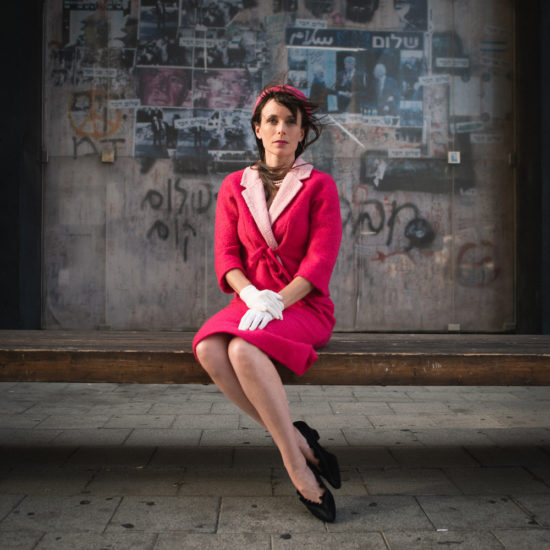
Photo by Yair Meyuhas
In the second part of the work, I parlayed the tour into a walkthrough of Jackie’s past and subconscious. Some of the material was derived from articles and books I read about her. Some of it was taken from my own past. I wove these bits together into an arc that included several movement and music sections that went from composed to chaos.
At the premiere, in June 2019, I was quite convinced that the finished work The Suit would be born and put to rest during the festival. In the weeks following, I understood that the work could live outside of the context of Intimadance and icons. I received several invitations to perform The Suit in other spaces. In the adapted versions, I kept the second part, the personal part, almost identical to how it was at Tmuna. I rewrote the tour part for each new space and gave the piece a different ending depending on what was available in the space. In Tmuna, I jumped on a weak spot on stage to make a loud BOOM. At the Hanut Gallery Theater in south Tel Aviv, I played a piano that was hidden behind a curtain on stage. At the Holon Theater, I swung open the theater door, marching out and leaving the audience behind.
Between March and October of 2020, I was meant to perform in Berlin, Vienna, Bergamo, Pittsburgh and Lisbon. But, of course, none of those tours came to pass.
When all performances were put on hold, the dance and theater communities scrambled to translate live events into digital engagements. In the height of the lockdown, I started to think about using Jackie to comment on the situation. I made two short videos in my home. In the first, Jackie is putting on latex gloves instead of her white, cotton ones. In the second, she covers her pink lipstick with a pink, velvet mask.
Shortly after, I proposed a tour of the closed Tmuna Theater, in its entirety, to Nitzan Cohen. He said yes. We went on to shoot two such tours, in the darkened, abandoned theater. We traipsed through the performance spaces, the hallways, the bathrooms and control booths, the technical caravan, the kitchen and the office. The digital tours were not a far leap from The Suit in that they existed in the space in which my Jackie came to life. The movement was left aside. I found myself, a dancer, in a purely theatrical realm. But, again, this wasn’t a big jump for Jackie to make. She was already something of a tour guide and her speech and gestures were the main distinguishing elements of the character.
In spring of 2020, while still on lockdown, I proposed a new work to the From Jaffa to Agripas Festival in which Jackie would give a tour of Jerusalem’s Mahane Yehuda Market, where the festival takes place each year. With this concept, I hoped to see what would happen to Jackie when she was out of the theater context and put in a location where real tours are given. There was some question in my mind about the idea. Would people be willing to go on a tour led by an American character from the 1960’s? What would she have to teach them about their own country?
In the coming months, I researched the market from afar. I spoke to vendors, store owners, bar owners, tour guides and locals about the market. I read everything I could find about the history of Mahane Yehuda. I listened to songs written about the market. Bit by bit, I composed a tour that focused on the untold stories of the shuk, the salacious details and hidden conflicts it encompasses.
Whereas The Suit was separated into two clear parts, the personal and the tour, Meet Me in the Market was more fluid. The market presented a huge mass of information and I wanted to be sure that I honored as much of it as I could. But I knew that without the Jackie parts, the tour wouldn’t make any sense. Finding a balance between the two proved to be the most difficult part of making this piece. I found segues and connections between the factual, market material and the Jackie bits. I linked the terrorist attacks that have taken place in the shuk with the attack on JFK and the “chamarot” or gentleman’s’ social clubs of the market with the debaucherous side of 1960’s America.
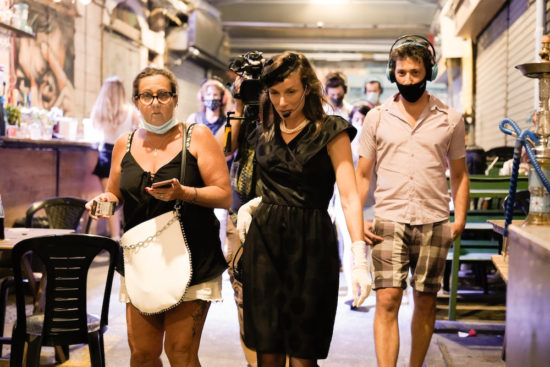
Photo by Efrat Mazor
As with any site-specific creation, all my plans only partially prepared me for the live performances. Over the two days of From Jaffa to Agripas, I led four tours. Each one was completely different as the market was in a different state every time we entered it. The first show of the evening coincided with the end of the day, the shutting down of stands and the final desperate shouts of the salespeople trying to get rid of the last of their goods. The second show of each night was at 9 PM, a time when the market had already changed its face to an open-air pub. Loud music, drunk kids and cigarette smoke replaced the pitas and produce. We wove our way through the crowded streets, the audience members wearing large headphones to hear my voice and the soundtrack. Places I had picked out to stop were suddenly filled with tables and chairs or heaps of trash or other performances. I had to think on my feet and stay keenly alert to the environment.
And while I am not a tour guide, I found myself giving a proper tour of a properly historic location. I relied on my skills as a journalist to sniff out the most interesting and rare details. I trusted that the character could carry the journey, that she could charm the audience into believing that she had something to reveal to them about a location that was local to them yet foreign to her.
The movement, or choreography, of this work was much more about keeping the audience on my trail and navigating the bustling market. Even the small choreographed movement sections were subject to sudden change.
After six months off stage, this was the most terrifying and challenging stage to return to. During the fourth show, a group of drunk teenagers got so close to me I considered stopping the show in the middle. People walked right through the semicircle the audience and I had made, brushing past me with their full shopping bags. I was looked at and laughed at and photographed all by people who had no idea what I was doing. And it struck me that placing dance in the public sphere is not just a quaint performance practice, it can also be unsafe. Perhaps that is the price of bringing our craft to places and people that would otherwise not see it.
In reflecting upon the various tours I have given as “Jackie”, the change in context marked the biggest shift for me, both as the choreographer/writer of the work and as the performer. On the stage, the frameworks are clear. There is no question as to whether what I am doing is real or not. All actions, even the most genuine, are abstracted to representation on the stage. Many argue that we can never be our true selves on stage because, in the eyes of the audience, every person is a character. You can only play the part of yourself; you can never just be. But in the public space, there is no disclaimer, no explanation, no distance between the true you and what you are performing. Passersby have no way of knowing, off hand, that this is a performance and not the unraveling of a lunatic. The realness of the environment forces a much greater commitment and concentration of the performer.

Photo by Efrat Mazor
As Jackie, I discovered that the public space offers as a big a reward as it does a challenge. Though at times I longed for the security of the black box theater, being outdoors on a real tour was the true test for the character and practice I had built. There were endless opportunities to improvise, to throw in a smile or wink at someone walking by, to help a mother carry her stroller down some stairs, all the while in a trim black dress, heels and a fascinator hat. Real life afforded me the opportunity to bring Jackie to life in a way I wouldn’t have been able to on stage. It allowed me to go from being a dancer to being a tour guide.
